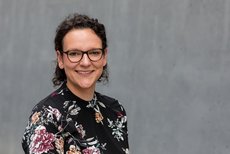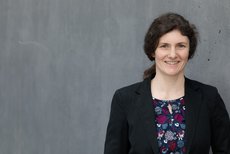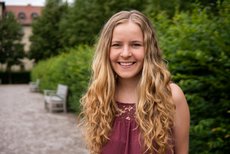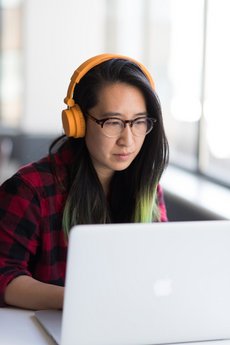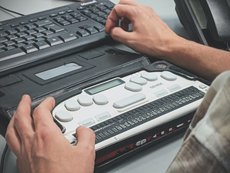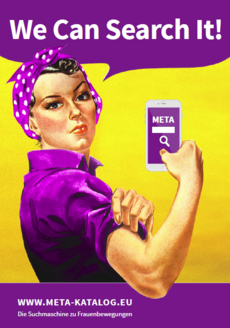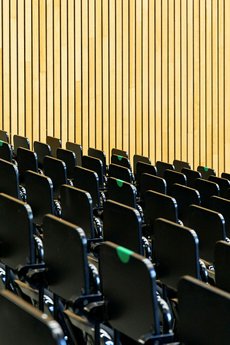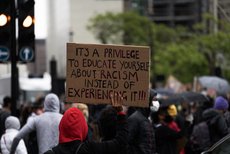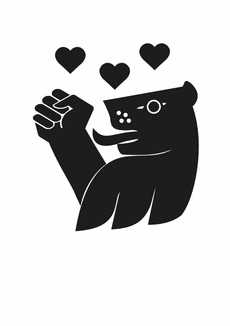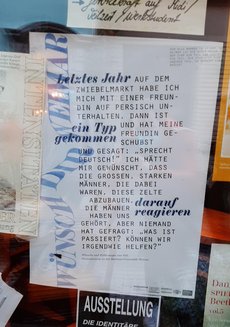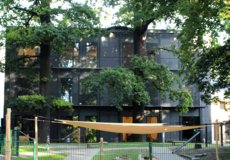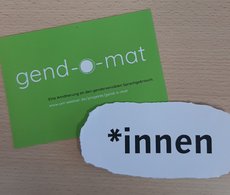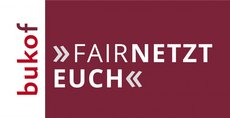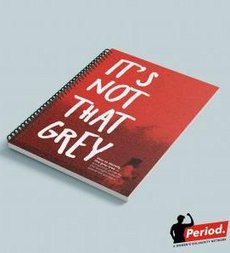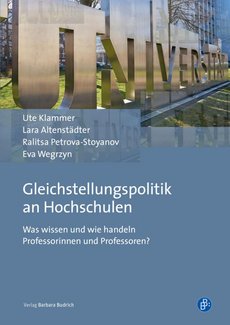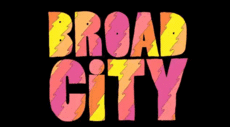
Für die deutschsprachige Version des Newsletters, bitte hier klicken.
Dear readers,
Thank you for your interest in the Bauhaus-Universität Weimar's Equal Opportunity Office and Diversity Department Newsletter! Our newsletter, published on a quarterly basis from now on, will introduce you to our work, offer an information exchange, and inform you about various projects, initiatives and events related to equality and diversity, both within and outside the university.
Why a joint newsletter?
The Diversity Department and the Equal Opportunity Office represent equal opportunities and are against discrimination, but they each focus on different target groups. While the Equal Opportunity Office focusses on gender equality and the advancement of women, the Diversity Department focusses on other forms of structural discrimination, such as racism, homo- and transphobia, or disability, and works towards equality in these areas. In terms of content, both units overlap when it comes to, for instance, gender diversity and gender-sensitive language. The issue of multiple, intersecting forms of discrimination against women who also belong to other structurally disadvantaged groups is another important area where our work overlaps.
We want to make these similarities, differences and overlaps visible in our joint newsletter.
We hope you enjoy reading it!
Best regards,
Tina Meinhardt
Equal Opportunity Officer of the Bauhaus-Universität Weimar
Dr. Miriam Benteler
Diversity Officer of the Bauhaus-Universität Weimar
Equal Opportunity Advisor
Dr. Michael Wallner
Equal Opportunity and Diversity Advisor
Franziska Fritsch
Equal Opportunity Office Administration
Table of Contents
INTRODUCTION
Since October 2019, Tina Meinhardt has been the Equal Opportunity Officer of the Bauhaus-Universität Weimar. Together with the Deputy Equal Opportunity Officer, Ricarda Löser, PhD, and the elected Equal Opportunity Advisory Board, she advocates gender parity and works towards the constitutionally guaranteed equal opportunities of women and men at the Bauhaus-Universität Weimar.
Here we introduce to you the Bauhaus-Universität Weimar’s Equal Opportunity Office, our activities and advisory services.
In November 2019, the Bauhaus-Universität Weimar established its Diversity Department and appointed Dr. Miriam Benteler as the university's first Diversity Officer.
Here we introduce to you the Bauhaus-Universität Weimar’s Diversity Department, our activities and advisory services.
In July 2020, Patricia Grass (Master's Degree in Construction Engineering, Faculty of Civil Engineering) and Antonia Ney (Master's Degree in Product Design, Faculty of Art and Design) were elected as Student Representatives to the Bauhaus-Universität Weimar’s Equal Opportunities Advisory Board. They have been working as contact persons for students from all faculties on the topic of gender equality in research and teaching since October 2020. They act as spokespersons for students, bringing their suggestions and criticism to the Equal Opportunities Advisory Board. We are pleased to introduce both Patricia Grass and Antonia Ney here.
CURRENT ISSUES
Reality is created through language. The use of gender-sensitive language is a simple but highly effective means of making everyone feel included and assuring equal treatment of all people, regardless of their gender or gender identity. The Equal Opportunities Office's German language guide — »Sprache gemeinsam verändern. Anregungen für einen gendersensiblen Sprachgebrauch« — points out various ways to avoid linguistic discrimination and include everyone linguistically. It is supplemented by the English guide »Changing Language Together. Guidelines for the Use of Gender-Inclusive Language« . This document offers tips and suggestions for gender-sensitive writing in English as an important scientific language.
With the start of the summer term, the Diversity Department, in cooperation with the eLab, has released information on how to make digital teaching accessible. Digital teaching, too, must be designed so that courses are fully accessible for students with disabilities.
Students with hearing or vision impediments are particularly dependent on digital accessibility.
Students with dyslexia or other reading disabilities, autism, certain psychological impairments or social difficulties, or students whose first language is not German may also benefit from accessible digital teaching. Precautions should be taken to compensate for potential sound issues, small displays, lack of technical equipment, or unstable internet connections. Ultimately, teaching content should be transparent and benefit all students through mediation using various senses and alternative forms of participation.
Oftentimes, digital accessibility requires only small adjustments. We encourage you to take accessibility into consideration already when planning your courses. Here you can find some recommendations for designing accessible teaching and learning materials, planning virtual team-work sessions, as well as synchronized and unsynchronized teaching formats. The Diversity Department is happy to support you in implementing these solutions!
As an interdisciplinary branch of research, women's and gender studies have permeated the fields of art and science. In Architecture and Urban Planning, as well as in cultural studies, media studies and engineering sciences, the analytical category of »gender« is also becoming increasingly important and becoming intertwined with other social order systems. Here are four online databases from the field of women's and gender studies. These may help you conduct in-depth research on the following topics: (1) Gender: Identity and Social Change, (2) META catalogue of the umbrella Organisation i.d.a., (3) Digital German Women's Archive (DDF) and (4) Open Gender Platform.
Germany-wide, the Coronavirus-pandemic has led to a reinforcement of the structural disadvantages experienced by women in science and science management. At the Bauhaus-Universität Weimar, the pandemic has also impacted studies, teaching, and research. Tina Meinhardt, Equal Opportunity Officer of the Bauhaus-Universität, sums up these developments for you here. Moreover, she makes recommendations regarding the daily work routines of students, teachers and researchers that can help to counteract the structural disadvantages experienced by women, specifically those reinforced by Covid19.
ANNOUNCEMENTS
During the winter term 2020/21, the Faculty of Architecture and Urbanism of the Bauhaus-Universität Weimar is hosting a public digital lecture series titled »Städte ohne Rassismus« (»Cities Without Racism«). How does racism play out in urban every-day life situations, for example, in the context of apartment-hunting, in the education system, or in interactions with institutions like the police? How can we intervene and work against it? Until mid-December, various scientists will speak to these and many more questions in the lecture series organized by Prof. Frank Eckard, Chair of Urban Studies and Social Research. In the new year, students, too, will present their projects on this topic, as the lecture series continues. You can find the full lecture program (until mid-December), more information, and the event-link here.
DOCUMENTATION
Under the motto »Decolonize Weimar!«, Media Studies and Media Art/Media Design students at the Bauhaus-Universität Weimar critically examined the town’s colonial history. Under the guidance of Dr. Julia Bee (Assistant Professor of Image Theory), they created an interactive map, a virtual city tour and several podcasts that invite visitors to explore the history and continuity of colonial racism in Weimar. We are excited to tell you about the multimedia project and reveal how you too can embark on a search for traces of colonialism in Weimar – digital or analogue. Click here for more information.
With a poster exhibition and a radio report on the topic »Wünsch Dir Weimar« (»Make a Wish for Weimar«), a digital edition of the »Language Café«, and a guided walking tour »Decolonize Weimar«, the Bauhaus-Universität Weimar took part for the first time ever in the Intercultural Week Weimar. This year, the theme of the nationwide event was »Zusammen leben, zusammen wachsen« (»Living Together, Growing Together«). In Weimar, Intercultural Week is organized annually by the City of Weimar’s Commissioner of Foreigners' Affairs and the Committee for Foreign Residents. You can find out more about the Bauhaus-Universität Weimar's contributions and on how the Diversity Office was involved here.
The Bauhaus Museum Weimar was converted into a temporary monument in the late evening of 27 September. As part of her multimedia project »walter ≠ bauhaus«, conceptual artist Larissa Barth projected black-and-white photos of 108 women, trans, intersex and non-binary individuals whose studies, research or work is connected to the Bauhaus onto the museum’s façade. Portraits of Tina Meinhardt (Equal Opportunity Officer) and Dr. Miriam Benteler (Diversity Officer) were also displayed. In a personal discussion, Barth explained to us how the project came to fruition, what cultural memory has to do with gender, why a century of cisgender male representation of the Bauhaus is enough, and how she writes women, trans and non-binary characters into history through her art.
DID YOU KNOW?
Already in 2008, the German Research Foundation’s (DFG) member organisations agreed to uphold »Research-Oriented Standards on Gender Equality« at the structural and personnel levels of academic research institutions. This year, the DFG examined the member organisations’ commitment through qualitative reports and revised its research-oriented standards accordingly. For the next three years, the DFG identified the following two key topics for a sustainable gender equality policy: 1.) Recruitment procedures to attract more women to academia, and 2.) Reducing the workload of female researchers to allow them to engage in committee work. You can find the full report on the DFG »Research-Oriented Standards on Gender Equality« 2020 (thus far, in German language only) here.
On 25 September 2020, the Studierendenwerk Thüringen inaugurated the new replacement building for the day-care center »campus.kinder«. The day-care center caters to members of the Bauhaus-Universität Weimar and their children. The new three-story timber-frame construction is located on the southern end of the university campus, in the immediate vicinity of yet another child-care-facility that opened several years ago. The new building can accommodate up to 60 children. Here you can find more Information.
The 28th updated edition of the standard German dictionairy Duden, which was released in August 2020, features for the first time an entry for the term »Genderstern« (gender star) or »Gendersternchen«.
Together with other newly added terms, such as »genderfluid«, »genderqueer«, »genderneutral«, »transgender« or »cisgender«, the Duden's new entry reflects the increasing social relevance of gender diversity in the German language and overall public discourse.
The language guide »Sprache gemeinsam verändern - Anregungen zum gendersensiblen Formulieren« of the Bauhaus-Universität Weimar's Equal Opportunity Office offers recommendations on the use of gender-inclusive language in German.
In May 2020, the Federal Conference of Women’s Representatives and Equal Opportunity Officers (bukof) released their »Guidelines for Gender Diversity in Universities«. The guidelines (in German language only) aim at strengthening gender diversity efforts and making gender diversity more visible. They are addressed to university administrators and diversity actors in academic institutions. The bukof calls on university administrations to »establish a social climate that enables Trans*, Inter*, and non-binary (TIN*) people to exercise their rights and to out themselves in their study or work environments without shame or fear of discrimination«. To achieve this goal, the bukof has issued recommendations for action in the following problem areas: name changes, gender entry options in digital registration systems, language and modes of address, as well as physical infrastructure.
The Bundeskonferenz der Frauen- und Gleichstellungsbeauftragten der Hochschulen (bukof) took the annual motto »FairNetzt Euch!« as an opportunity to draw attention to the difficult working conditions in university administrative offices. Staff of the administrative offices are called upon to take part in the bukof social media campaign #FairNetztEuch and to share their experiences with the Bauhaus-Universität Weimar Equal Opportunities Officer. You can find out more about the bukof campaign here.
LITERATURE TIPS
We live in a world where the vast majority of women* will be the target of harassment, sexual assault or rape at some point in their lives. The hands-on guide »It's Not That Grey: How to Identify the Grey Area — A Practical Guide for the Twilight Zone of Sexual Harassment«, written by Sara Hassan und Juliette Sanchez-Lambert and published by the Brussels-based group »Period. A Women*s Solidarity Network«, deconstructs the so-called »grey zone« of sexual harassment by giving concrete tools to identify, bust myths around and fight harassment. With their »Red Flag System«, Hassan and Sanchez-Lambert help potential targets and bystanders of harassment to identify early instances of sexual harassment, and to change society for the better.
You can download »It's Not That Grey« for free as an Open Access pdf from the website of »Period. A Women*s Solidarity Network«.
In November 2020, the Viennese ÖGB-Verlag published a German-language translation of the guide, titled: »Grauzonen gibt es nicht — Muster sexueller Belästigung mit dem Red-Flag-System erkennen«. The German-language guide can be ordered in hardcopy-format (subject to costs). It is also freely available as Open Access pdf.
What do professors know about issues of gender and equal opportunity politics, and how do they practice gender equality in their respective leadership-positions in research, teaching and academic self-governance? The book »Gleichstellungspolitik an Hochschulen. Was wissen und wie handeln Professorinnen und Professoren?« aims at shining a light on the interplay of professors' knowledges and attitudes, on the one hand, and their motivations for action with respect to gender equality, on the other.
On the publisher's website, you can either download the book for free as an Open Access pdf or order a hard-copy (subject to costs).
In her article »Zielkonflikte: Was Professor_innen über Gleichstellung denken« (»Conflict of Goals: What Professors Think About Equal Opportunity Politics«) for the »blog interdisziplinäre Geschlechterforschung« (»blog interdisciplinary gender studies«), Eva Wegrzyn looks at professors' attitudes towards the issue of equal opportunities for women at universities.
TV GUIDE
»Deeply weird and weirdly sweet« - this is how Entertainment Weekly describes the US-American sitcom »Broad City«, which revolves around the lives of two Jewish women living in 1920’s New York City. Creators and leading actors of the show are Ilana Glazer and Abbi Jacobsen. In »Broad City«, the two comedians paint a diverse, relentless, and hilarious picture of non-conformist women. In contrast to many other shows with and about women, the stories rarely deal with the characters’ outward appearances or careers. Instead, »Broad City« offers harsh and at times vulgar tales of sexual liberation, financial constraints, and female empowerment — and it is extremely funny!
Do you have any recommendations for feminist or queer TV-shows or books that we should highlight here? Please send them to: gleichstellungsbuero@uni-weimar.de.
